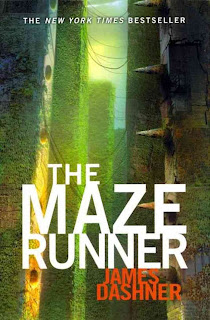The Maze Runner. The Scorch Trials.
The Death Cure.
And I just have to say..."Good that." These book were my favorite Young Adult fiction of the year, as I said in my 2013 Summer Reading List and Recommendations. I gushed about them there and in my reviews of the three books, which you can find by clicking through these links: The Maze Runner, The Scorch Trials, and The Death Cure.
But this whole series by James Dashner also taught me some lessons about killing off a reader's friends: the characters.
In my experience, male authors of Young Adult Fiction don't hesitate to break a reader's heart for fear of reader displeasure. Nope. They go there. I wouldn't call them "insensitive" to the reader's emotions, but they aren't entirely "sensitive" either. Perhaps that's a bit of a generalization, but I've noticed it with a couple of them*, including James Dashner.
*Scott Westerfield in his Uglies series is one, and John Green seems to have the same idea, although, I admit I haven't ever finished one of his books.
One particular character in this series stole my heart (typically, if I like a book, it's because a character stole my heart). And then Dashner killed said character. This is something I can understand, even though I hate it. Sometimes, a character must die to keep the integrity of the plot, to teach another character a lesson, or to add another layer of meaning to the message of a novel.
It's a risky move. After all, you want to leave your readers with some happy feelings intact by the end of the story. If you kill off their favorite character, they might just stop reading. Would I have done it what Dashner did? I don't know! He didn't pull any punches with this character--brutal death, very tragic. Still, he did it well. The situation met all of the criteria I mentioned--it kept the integrity of the plot, taught a character (and the world of the book, and a reader) a lesson, and it added layers of meaning to the novel. It still sucks, but I understand.
But then he killed off an interesting character when he could have instead killed off a less interesting secondary character. Granted, I was not even very fond of the interesting character (and from the reviews, I see that most aren't), but the death still shocked me. It was so unexpected and, well, detrimental. Whatever point Dashner was making with that kill, it was fairly lost on most readers. Why kill the interesting one, the one the readers know and understand better?
So overall, Dasher killed off not one but two major characters--one a major favorite, the other a more interesting character than her competitor. I felt like hosting a funeral after reading this series. For days, poor Kevin had to deal with Snivelly Christy asking, “Why? Why did Dashner do it? It’s not fair!” Both kills were very risky moves. On one hand, you don't want your book to be forgettable, and Dashner's work certainly isn't that. On the other hand, you want your readers to care about the resolution. If you lose them when you kill off their favorite characters, or your ending falls flat because you killed off the more memorable or interesting ones...well, you lose readers.
One risk paid off, one didn't. I learned from this, and you can too, Scribbler.
What I learned:
1.) Be in touch with your readers. Give them something to be happy about at the end. Dashner gave a psychologically satisfying ending, but the emotional satisfaction took some time to show up. At first, I just felt like a friend died. I actually had to take a break from reading for a bit and get back some perspective. I really had to let the novels sit on me before I "got over it" and realized what an unforgettable story they told. I know for a fact that Dashner was sad about killing the first character (my favorite) because he said as much on Twitter. He was in touch, he knew the cost and he paid it.
2.) Be careful who you decide to kill and who you decide leave behind. When Dashner killed off the other interesting character, I thought, "Well, how boring for the survivors!" I'm sure he measured the cost, here, but I think he made the wrong decision.
But this is truly great entertainment, Bandits- 4.25/5 stars, I'd give it. Great "boy" appeal, too. There are few Young Adult books so perfectly geared to male teenagers.
These books are on ebook and audiobook at the library through Overdrive Media Console. They're also available through the free mail order system from nearby libraries (for Lake County Book Bandits). Read them before the movie comes out!!!
The movie is set to open on February 14, 2014 (thanks to GreenBeanTeenQueen's blog for the news).
P.S. Check out this adorbs pic of The Maze Runner actors on set. It's entitled "Maze Life." "Thomas" is the farthest actor to the right.
P.P.S. There is a prequel to this series...and I didn't really like it. It feels sort of irrelevant to the whole series. If you would like to read my review of it, here 'tis.





